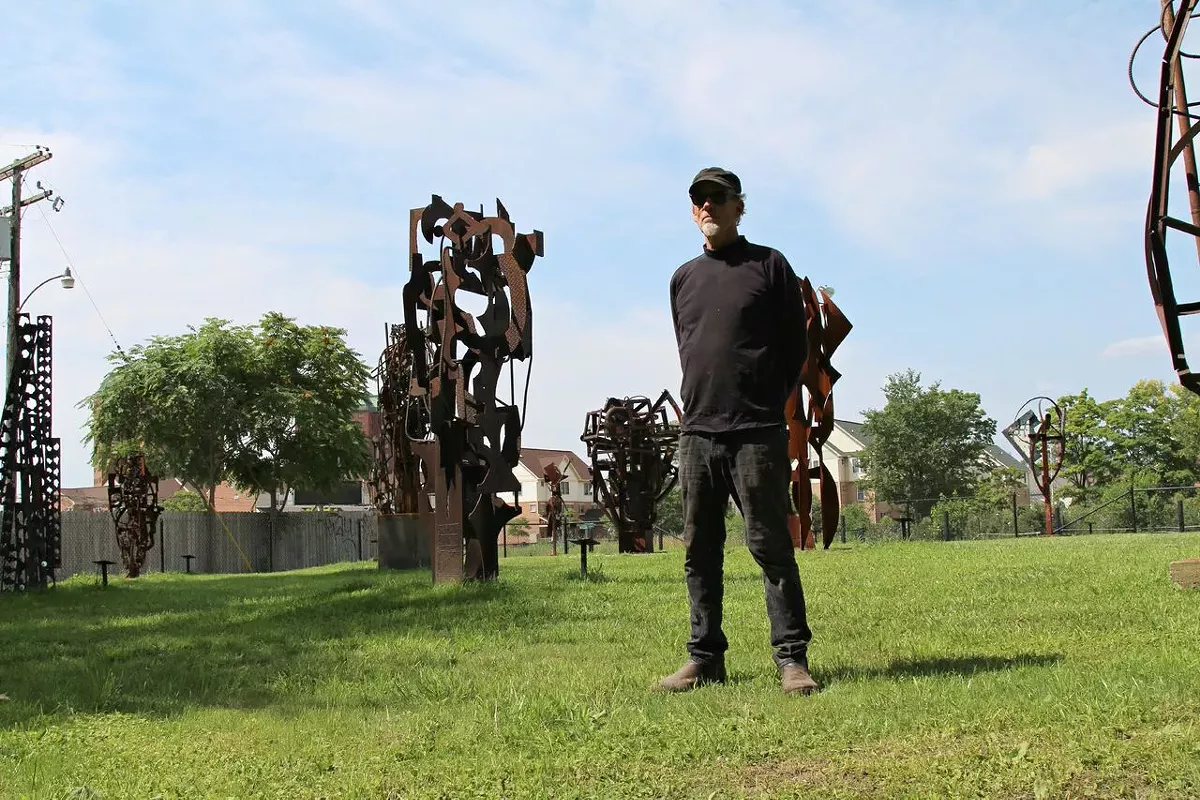There are 29 welded steel sculptures, most around 8 feet tall. You don't notice at first that they're in a perfect grid, spread throughout the recently mowed corner lot on Alexandrine Street at Lodge Service Drive, close to Cass Corridor and adjacent to the freeway, which provides constant ambient sound. These are playful, incredible works. Most are orange with rust. Some are more successful as sculptures than others, but it's the entirety of the thing that is the real work of art. On a bench in the middle, we're greeted by a tall, slim figure.
Robert Sestok is spoken of around town fondly as the Cass Corridor artist who stuck around, who never left Detroit. He did leave for a spell in the 1970s to live with his then-girlfriend (the renowned artist Kiki Smith), but he returned by 1980. Animated and kind, Sestok embodies the city's DIY ethos so thoroughly that one searches for new words to describe him and his work.
This is one person who not only conceived of a sculpture park filled with his own art, but he created enough work to fill it, convinced his neighbors and local government to allow it, raised the money all by himself, bought the empty lot for the space one block from his house, and then executed all of it. He's had a lot of help from family and friends, but he even self-published the art book, Selected Art Works: 2004-2014, that will be available at the park's opening July 10. You can pretty much only get it from him now, and that seems just as it should be.
Sestok might be the most important living Detroit artist. He's probably the most prolific, and stylistically diverse. We were afforded a sneak preview of the park, and spoke with him among the towering works.
Metro Times: Tell me about the works here.
Robert Sestok: So there are different types of work out here. It's basically abstract, welded steel stuff. Some of it has narration to it, where there are some figures cut out of metal and then welded to it. And I kind of think that some of this is very ornamental, being abstract. It just has that feeling of ironwork that is very decorative, in some instances. I'm still exploring ideas about constructing sculptures out of steel, and I also weld stainless steel and bronze together. I don't like to work in aluminum. I do like the rust, I like the way the rust looks — it's very human. I put oil on top of the rust, and that kind of preserves it a little bit from oxidation, makes it have a little bit longer life span.
MT: So, this piece here. How many hours of your life is inside that thing?
Sestok: Well, it's hard to say because this piece is a combination of a lot of different pieces that I cut up, and then put together.
MT: They didn't work separately?
Sestok: They worked, but I was trying to make a statement about combining work together. I call it "the Dream Machine" because it has a lot of combined sculptures in it, years of making sculptures. I used some other techniques with re-rod and some other stuff that I hadn't done before. I was thinking about what if we took all the sculptures that were really famous sculptures and put them together as one sculpture? How would that look? In fact, my original idea for this park was to stick all this stuff together, all the work into one big ball. People were saying, "You don't really want to do that." But maybe I still will. Maybe I'll just bring all these things together in the middle here, and build it 40 feet tall.
This piece over here is all propane tanks — both of these are 500-gallon propane tanks that I cut up and reassembled. A lot of this is deconstruction and reconstruction. And that's been the theme for the Cass Corridor movement in the '70s, with people breaking stuff and putting it back together and hanging it on the wall — that kind of process.
MT: Were you guys influenced by the California assemblage movement of the '50s, with Wallace Berman, Jay DeFeo, and Bruce Conner?
Sestok: Not really. We were our own; we were seeing what we could come up with. There were a couple studios off of Cass Avenue, and we had one group here and one group there and we'd all meet at the bar and everyone would talk. Eventually, this whole process started to come together. And there was a gallery, and people would work in their studios and have shows in the gallery. So every 12 months, you could have a show. So every year, it was possible to exhibit what you had created.
MT: Sounds like an ideal incubator.
Sestok: It was an incubatory situation, but it grew into the only art movement in the history of the city of Detroit that has ever occurred — where people came together and created a specific idea of what art was, art is.
MT: What do you think the chances of getting another going are?
Sestok: An incubator? They're happening all over town now.
MT: No, another art movement happening here? Or maybe it would have to be mini-movements.
Sestok: People aren't together; it's too spread out. And although people know what's going on, it's a bigger community for the arts than it was back in the '70s.
MT: So where do you think you stand on the issue of style? Because to look at your different ways of making sculpture, plus how your paintings and prints over the years look so varied.
Sestok: It's all over the place. And people are always saying, "What are you about, what is your work about?" And you know, I think it's about diversity. I'm really all over the map. Did you know Jackson Pollock made pottery? Artists go through a lot of transitions in getting to where their work is recognized for what it is. The sculpture park is an example of all the transitions I have been going through. I still have a lot of ideas about what I want to do — it's not just about one thing to me. If I feel good about an idea. I go for it.
The public unveiling of City Sculpture Park will include a book release party and signing, with special kids sculpture activities and a performance by the band Botanical Fortress. Please do not climb on the sculptures. It happens from 5 p.m. to 10 p.m. Friday, July 10 (with a rain date of July 11); 955 W. Alexandrine St., Detroit; free.








